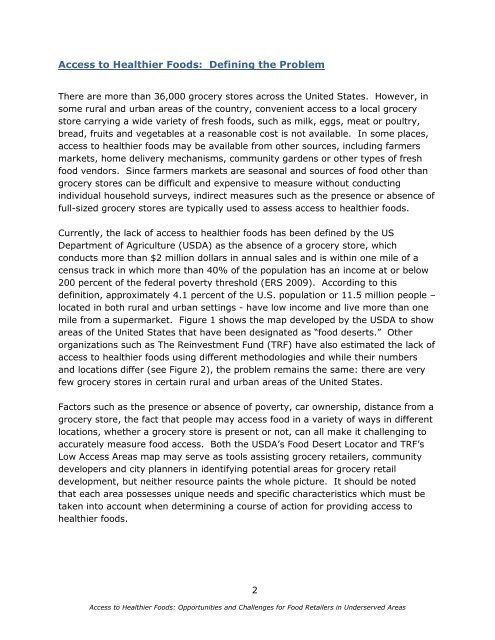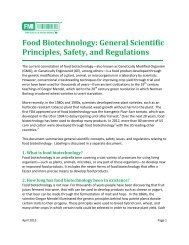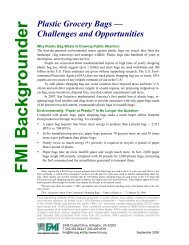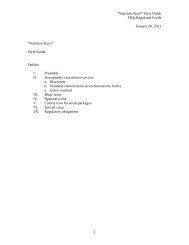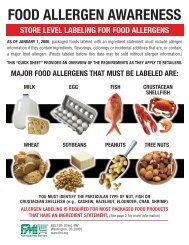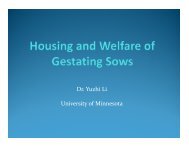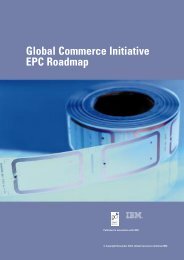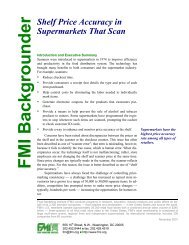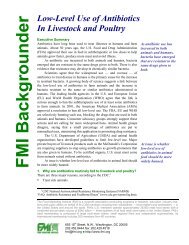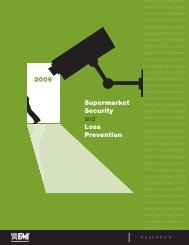Untitled - Food Marketing Institute
Untitled - Food Marketing Institute
Untitled - Food Marketing Institute
You also want an ePaper? Increase the reach of your titles
YUMPU automatically turns print PDFs into web optimized ePapers that Google loves.
Access to Healthier <strong>Food</strong>s: Defining the Problem<br />
There are more than 36,000 grocery stores across the United States. However, in<br />
some rural and urban areas of the country, convenient access to a local grocery<br />
store carrying a wide variety of fresh foods, such as milk, eggs, meat or poultry,<br />
bread, fruits and vegetables at a reasonable cost is not available. In some places,<br />
access to healthier foods may be available from other sources, including farmers<br />
markets, home delivery mechanisms, community gardens or other types of fresh<br />
food vendors. Since farmers markets are seasonal and sources of food other than<br />
grocery stores can be difficult and expensive to measure without conducting<br />
individual household surveys, indirect measures such as the presence or absence of<br />
full-sized grocery stores are typically used to assess access to healthier foods.<br />
Currently, the lack of access to healthier foods has been defined by the US<br />
Department of Agriculture (USDA) as the absence of a grocery store, which<br />
conducts more than $2 million dollars in annual sales and is within one mile of a<br />
census track in which more than 40% of the population has an income at or below<br />
200 percent of the federal poverty threshold (ERS 2009). According to this<br />
definition, approximately 4.1 percent of the U.S. population or 11.5 million people –<br />
located in both rural and urban settings - have low income and live more than one<br />
mile from a supermarket. Figure 1 shows the map developed by the USDA to show<br />
areas of the United States that have been designated as “food deserts.” Other<br />
organizations such as The Reinvestment Fund (TRF) have also estimated the lack of<br />
access to healthier foods using different methodologies and while their numbers<br />
and locations differ (see Figure 2), the problem remains the same: there are very<br />
few grocery stores in certain rural and urban areas of the United States.<br />
Factors such as the presence or absence of poverty, car ownership, distance from a<br />
grocery store, the fact that people may access food in a variety of ways in different<br />
locations, whether a grocery store is present or not, can all make it challenging to<br />
accurately measure food access. Both the USDA’s <strong>Food</strong> Desert Locator and TRF’s<br />
Low Access Areas map may serve as tools assisting grocery retailers, community<br />
developers and city planners in identifying potential areas for grocery retail<br />
development, but neither resource paints the whole picture. It should be noted<br />
that each area possesses unique needs and specific characteristics which must be<br />
taken into account when determining a course of action for providing access to<br />
healthier foods.<br />
Access to Healthier <strong>Food</strong>s: Opportunities and Challenges for <strong>Food</strong> Retailers in Underserved Areas<br />
2


